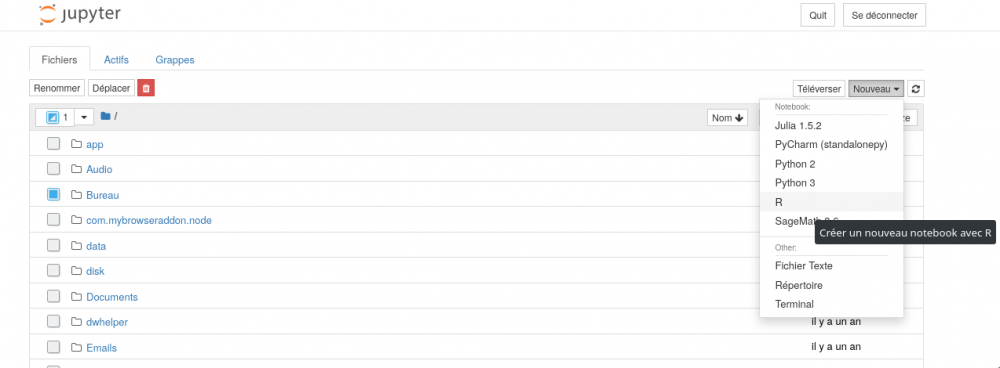Liens web semaine 46 - 2020
Vu cette semaine
Vu cette semaine
Chercher une chaîne texte dans les fichiers d'une arborescence :
find ./ -type f -print0 | xargs -0 grep "mon texte"ou
grep -r "mon texte" .ou
rgrep "mon texte" .
L'objectif est de rendre possible l'utilisation de Julia et de R sur un serveur de notebook Jupyter en installant leur Ikernels respectifs
Dans la console :
Pkg.add("IJulia")
https://datatofish.com/add-julia-to-jupyter/
Dans la console :
install.packages('IRkernel')
Rkernel::installspec() # pour l'utilisateur courant
IRkernel::installspec(user = FALSE) # pour tous les utilisateurs si la console est lancée en tant que 'root'
https://irkernel.github.io/installation/
https://www.unkm.fr/ |
 |
Comment ça marche ? Zoomez sur votre lieu de confinement. Vous pourrez dessiner l'itinéraire de promenade circulaire. |
 |
Julia by exemple : " Set of unofficial examples of Julia the high-level, high-performance dynamic programming language for technical computing.Below are a series of examples of common operations in Julia. They assume you already have Julia installed and working (the examples are currently tested with Julia v1.0.5)."
Juno : "Juno is an Integrated Development Environment (IDE) for the Julia language. It provides powerful tools to help you develop code. Juno is built on Atom, a text editor provided by GitHub. Juno consists of both Julia and Atom packages in order to add Julia-specific enhancements, such as syntax highlighting, a plot pane, integration with Julia's debugger, a console for running code, and much more."
Une introduction à Julia : "Une introduction à Julia sous forme de Notebook (Jupyter). La visualisation est automatique sous Github, pour rendre interactif les Notebook il faut "cloner" le répertoire sur sa machine (ou sur un serveur Jupyter).Toute contribution est la bien-venue à l'aide d'un simple "pull request".
T. Clopeau"
JuliaGeo : "JuliaGeo is an organization that contains a number of related Julia projects for manipulating, querying, and processing geospatial geometry data. We aim to provide a common interface between geospatial packages."
Site Julia de l'université de Nantes : "Lancé en mars 2019, JuliaNantes vise à partager avec les visiteurs nos productions, expériences, enseignements, événements, etc. en Julia.
Nous concernant, Julia a été adopté à la faculté des sciences et des techniques de l’Université de Nantes comme langage de programmation support à différents enseignements relevant de l’optimisation en recherche opérationnelle depuis 2015, et comme langage support à nos productions logicielles réalisées dans nos travaux de recherche en optimisation multi-objectif depuis 2017.
Constatant l’absence de matériel en langue française, les parties non techniques du site se présentent en français."
DataFrames.jl : " This resource aims to teach you everything you need to know to get up and running with tabular data manipulation using the DataFrames.jl package. For more illustrations of its usage in conjunction with other packages, the DataFrames Tutorial using Jupyter Notebooks is a good complementary resource.
DataFrames.jl provides a set of tools for working with tabular data in Julia. Its design and functionality are similar to those of pandas (in Python) and data.frame, data.table and dplyr (in R), making it a great general purpose data science tool, especially for those coming to Julia from R or Python."
Think Julia: How to Think Like a Computer Scientist : "The goal of this book is to teach you to think like a computer scientist. This way of thinking combines some of the best features of mathematics, engineering, and natural science. Like mathematicians, computer scientists use formal languages to denote ideas (specifically computations). Like engineers, they design things, assembling components into systems and evaluating trade-offs among alternatives. Like scientists, they observe the behavior of complex systems, form hypotheses, and test predictions."
À la découverte de Julia : "Dans cet article, je vais vous présenter un nouveau langage, Julia. Ce langage est en développement au MIT depuis 2009 et la première version publique date de 2012. Il est actuellement en phase de stabilisation des fonctionnalités pour sa version 0.7. auteur : LuthafP"